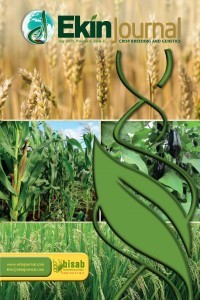Safflower (Carthamus tinctorius L.) breeding activities at Trakya Agricultural Research Institute
Safflower (Carthamus tinctorius L.) breeding activities at Trakya Agricultural Research Institute
___
- Anonymous (2013a). Ministry of Food Agriculture and Livestock (www.tarim.gov.tr)
- Anonymous (2013b). Turkish Statistical Institute, Annual Reports. (www.tuik.gov.tr)
- Bagavan I and R L Ravikumar 2001. Strong undesirable linkages between seed yield and oil componentsA problem in safflower improvement. Proceeding of the V International Safflower Conference, USA, July 23-27, pp: 103-107.
- Corleto A, Cazzato E and Vetricelli P (1997). Performance of hybrid and O.P. safflower in two different Mediterranean environments. Proceedings of the Fourth International Safflower Conference. Italy, Bari, 2-7 June, pp. 276-278.
- Dincer N 1964. Aspir (Safflower) Tarım Bakanlığı, Ziraat İşleri Genel Müdürlüğü Yayınları, D-102. 8 sayfa
- Golkar P, Arzani A and Rezaei A M (2011). Determining relationships among seed yield, yield components and morpho-phenological traits using multivariate analyses in safflower (Carthamus tinctorious L.) Annals of Biological Research . Vol. 2 Issue 3, p. 162-169
- Golparvar A R (2011). Genetic Improvement of Oil Yield in Spring Safflower Cultivars under Drought and Non-drought Stress Conditions Electronic Journal of Biology, Vol.7(2): 40-43
- Harishbabu A N, Rudna Naik, V, Hanumantharaya L, Raju S G and Yaragoppa S D (2005). Evaluation of Promising Breeding Lines of Safflower for Alternaria Tolerance, Seed Yield and its Components. Karnataka Journal of Agricultural Sciences: 18 (3) p. 803-80
- Jamshi-Moghadam M, Pourdad S S 2006. Determination of safflower genotypes under moisture stress in controlled conditions and field. Journal of Agricultural and Natural Resources 10(2), 155- 167.
- Johnson R C, Ghorpade P B and Bradley V C 2001. Evaluation of the USDA core safflower collection for seven quantitative traits. V. International Safflower Conference. USA. pp. 143-149.
- Mozaffari K and Asadi A A (2006). Relationships among traits using correlation, principal components and path analysis in safflower mutants sown in irrigated and drought stress condition. Asian. J. Plant. Sci, 5(6): 977-983.
- Narkhede B N and Deokar A B 1990. Inheritance of spininess and pericarp types in safflower. J. Maharashtra Agric. Univ. 15, 279–281.
- Pahlavani M H, Saeidi G and Mirlohi A F 2004. Inheritance of flower color and spininess in safflower (Carthamus tinctorius L.). J. Hered. 95, 265–267.
- Ramachandran M 1985. Genetic improvement of yield in safflower – problems and prospects. Journal of Oilseeds Research, 2: 1-9
- Rao V and Ramachandram M (1997). An analysis of association of yield and oil in safflower. Fourth International Safflower Conference. Italy, Bari, 2-7 June, pp. 185-191.
- Zheng N, Futang C and Xinchun S, et al. (1993). Path analysis of correlated characters on flower yield of safflower, Third Int. Safflower Conf. Nijing, China, 582-588
- ISSN: 2149-1275
- Yayın Aralığı: Yılda 2 Sayı
- Başlangıç: 2015
- Yayıncı: Bitki Islahçıları Alt Birliği
Ievgenij V. Zaika, Anatolii V. Karelov, Natalija O. Kozub, Igor O. Sozinov, Oleksij O. Sozinov, Vasyl M. Starychenko
Youkabed Zarroug, Jamel Mejri, Noussaiba Dhawefi, Safouane Ben Sik Ali, Mouldi EL Felah, Mnasser Hassouna
A promising fruit: Cherry laurel (Prunus Laurocerasus L.) and steps on breeding
Melekber Sulusoglu, Aysun Cavusoglu, Suleyman Erkal
Safflower (Carthamus tinctorius L.) breeding activities at Trakya Agricultural Research Institute
Tofig I. Allahverdiyev, Javanshir M.Talai, Irada M. Huseynova, Jalal A.Aliyev
Assessment of pollen viability and germination in seven varieties of lemon
Gulay Demir, Ertugrul Turgutoglu, Senay Kurt
“BATEM Göral”; New mandarin cultivar
Senay Kurt, Ertugrul TURGUTOGLU, Gulay DEMİR
Necmi BESER, Halil SUREK, Recep KAYA
Establishing core collections for enhanced use of germplasm in crop improvement
Reaction of wheat germplasm to stem rust in Georgia
Zoia Sikharulidze, Lali Mgeladze, Rusudan Dumbadze, Ketino Natsarishvili, Nana Chkhutiashvili
